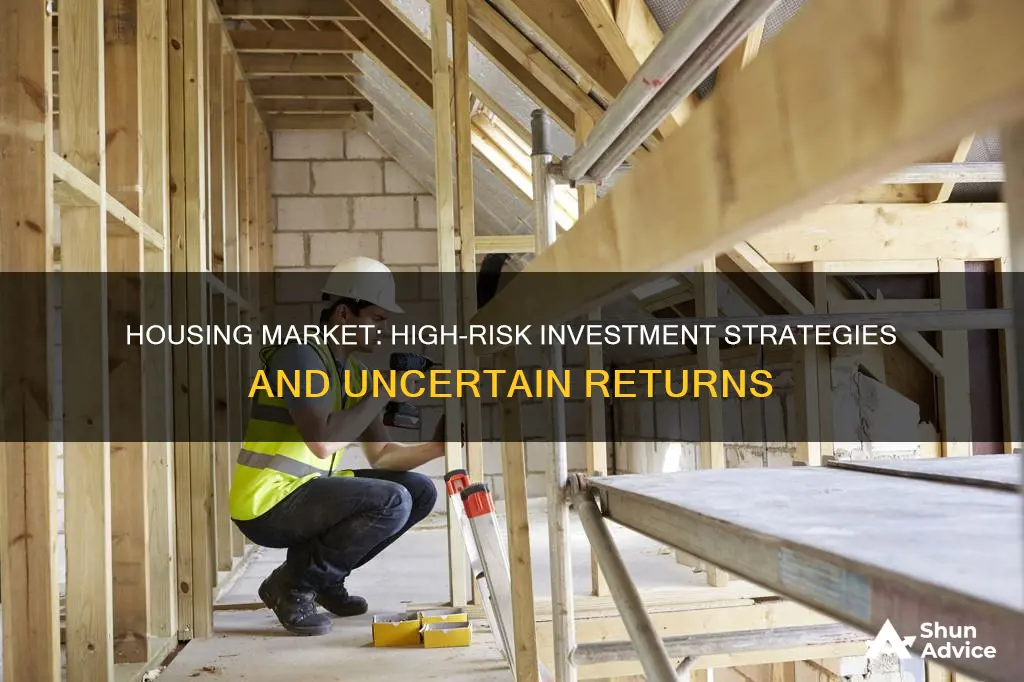
Housing is often considered a low-risk investment compared to stocks, annuities, and cryptocurrencies. However, it is not risk-free. Real estate markets are cyclical, with significant price fluctuations, and market downturns can result in temporary or long-term losses. There are several risks associated with housing as a high-risk investment, including bad locations, negative cash flow, high vacancies, problematic tenants, hidden structural problems, lack of liquidity, and the unpredictable nature of the real estate market. These risks can lead to financial losses and impact the overall financial stability of investors.
| Characteristics | Values |
|---|---|
| Market Risk | Property values or rental rates can decline due to changes in the local market or global economy |
| Location Risk | Changes in the neighborhood, such as new construction or declining local economies, can impact property values |
| Property-Specific Risk | Issues like structural problems, poor construction, or outdated systems can lead to unexpected costs |
| Liquidity Risk | Traditional real estate investments have low liquidity, making it challenging to convert assets to cash quickly |
| Financing Risk | Changes in interest rates can impact the profitability of an investment property |
| Tenant Risk | Difficult tenants can cause issues like property damage, missed rental payments, and unexpected vacancies |
| Management Risk | Poor property management can lead to increased vacancy losses, higher maintenance costs, and reduced property value |
| Legal and Regulatory Risk | Changes in laws and regulations can affect the profitability of real estate investments |
| Environmental Risk | Natural disasters and climate change can damage properties and reduce their value |
| Tax Risk | Rising property taxes and changes in tax policies can impact the net return on real estate investments |

Market risk
To mitigate market risk in real estate investing, it is advisable to diversify investments and spread the risk across a wider section of the market. It is also recommended to invest in rental properties with strong tenant demand to ensure a steady income during market downturns.
Despite the risks, real estate is widely considered a low-risk investment compared to other types of investments, such as stocks, annuities, and cryptocurrencies. This is because real estate is a tangible asset that will always retain some value, even if the market temporarily dips. Additionally, as housing is an inelastic commodity, it is less affected by changes in economic conditions than more volatile investments.
Africa's Small Investment Guide: Getting Started
You may want to see also

Location risk
Location is a critical aspect of real estate investment that can significantly influence potential returns and risks. Here are some key factors that contribute to location risk:
Neighborhood and Regional Factors
The desirability and value of an investment property are heavily influenced by neighborhood factors such as crime rates, school quality, transportation access, and proximity to amenities. Regional factors like job growth, population trends, and infrastructure development also play a crucial role in shaping housing supply and demand. These factors can impact rental rates, occupancy levels, and potential returns. For example, locations with limited housing supply often experience higher rental demand, leading to increased occupancy rates and rental income for investors. On the other hand, areas with less desirable environmental conditions or declining populations may face slower appreciation rates and higher vacancy rates, resulting in lower potential returns.
Economic Conditions
Economic conditions, such as the strength of the local economy, job market, and access to amenities, can attract investors and impact property values. Locations with favorable economic prospects, including growing economies, robust job markets, and thriving businesses, tend to experience higher property values and potential returns. Prospective investors should analyze various economic indicators, such as GDP growth, unemployment rates, and industry diversification, to make informed decisions about where to invest.
Zoning Laws and Regulations
Zoning laws and regulations can significantly impact real estate investments. Investors should research these laws to understand any restrictions on property use and how their investments fit within the local zoning regulations. Changes in zoning rules, such as restricting certain property types or rentals (e.g., banning short-term rentals), can directly affect the real estate market and an investor's portfolio.
Infrastructure and Development
The quality of local infrastructure and development plans can affect real estate investment returns. Well-developed areas with good transportation systems, accessible public services, and thriving businesses tend to have higher property values. Additionally, upcoming development projects, such as the construction of a new Metro line, can positively or negatively impact rental rates and property values during the construction phase.
Macroeconomic and Microeconomic Factors
Favorable macroeconomic and microeconomic conditions can enhance the value and potential returns on real estate investments. Microeconomic factors like household income, income distribution, and local employment rates have a direct effect on investment returns. Understanding these factors can help investors make more informed decisions and maximize their returns over the long term.
Natural Disasters
While this is not exclusive to location risk, it is worth noting that natural disasters and climate change can damage properties and reduce their value. Therefore, investors should consider choosing locations with a lower risk of natural disasters to mitigate this particular risk.
Shark Tank India Success Stories: How Many Paid Off?
You may want to see also

Property-specific risk
To mitigate property-specific risk, it is recommended to conduct extensive due diligence checks, including hiring licensed home inspectors to evaluate the property's condition. Purchasing properties with warranties or guarantees, and budgeting for potential repairs and maintenance can also help reduce this risk.
Another aspect of property-specific risk is the physical condition of the property. Properties may have hidden defects or require extensive renovations, resulting in unexpected and expensive costs. Even if a property appears fine, there could be underlying issues with the foundation, roof, plumbing, or electrical systems. If left unaddressed, these problems can escalate and lead to costlier repairs down the line. Hiring a professional inspector before purchasing a property can help identify these issues and allow for negotiation with the seller or the option to back out of the deal.
Additionally, property-specific risk can be influenced by the property's location. Factors such as crime rates, school quality, transportation access, and proximity to amenities can impact the desirability and value of the investment property. Regional considerations like job growth, population trends, and infrastructure development also play a role in housing supply and demand. Therefore, researching location dynamics and visiting potential sites in person are crucial steps in mitigating property-specific risk.
Leverage: Reducing Investment Risk or a Double-Edged Sword?
You may want to see also

Liquidity risk
The impact of liquidity risk on housing market performance has been studied, with findings suggesting that a higher level of housing liquidity leads to lower subsequent housing returns. This means that investors in the housing market may incur a higher level of liquidity risk due to the nature of the market, which is less liquid than the financial market.
The time it takes to sell a property and the transaction costs involved can affect the reservation price set by buyers and sellers. If liquidity deteriorates and transaction costs increase, it can negatively impact current housing prices and increase the expected return. On the other hand, an unexpected positive liquidity shock can lead to a rise in prevailing housing prices.
Additionally, the housing market is characterised by information asymmetry, costly searching, inelastic supply, and short-sale constraints. Housing investments are often a large proportion of an individual's financial risk and are challenging to diversify.
To mitigate liquidity risk in real estate investing, one can consider modern real estate investments with higher liquidity, such as real estate syndication, or explore options for converting home equity into cash, like home equity loans.
Understanding Your Options House Investments Better
You may want to see also

Financing risk
Housing is generally considered a low-risk investment compared to other types of investments such as stocks, annuities, and cryptocurrencies. However, it is important to note that all investments carry some degree of risk. Financing risk is one of the key risks associated with investing in housing.
To mitigate financing risk, investors can consider the following strategies:
- Locking in fixed-rate mortgages to stabilise interest expenses, with the option to refinance if rates drop.
- Maintaining a good credit score to secure more favourable loan terms.
- Avoiding over-leveraging by keeping a healthy debt-to-equity ratio.
- Only borrowing what they can afford to pay back and maintaining cash reserves for emergencies and changes in interest rates.
Additionally, investors can consider real estate syndication, where multiple investors pool their funds to finance a single project. Syndication companies typically have more negotiating power and can secure better loan terms due to the high volume of deals they handle.
It is also important to note that financing risk is just one aspect of the overall risk associated with housing investments. Other risks include market risk, property-specific risk, location risk, liquidity risk, tenant risk, management risk, legal and regulatory risk, environmental risk, and tax risk. Each of these risks should be carefully considered and mitigated to make informed and confident investment decisions.
Investing in Chaos: Strategies for Uncertain Times
You may want to see also
Frequently asked questions
Real estate is considered a low-risk investment because it is a tangible asset that will always retain some value. It is an inelastic commodity, so it is less affected by changes in economic conditions than volatile investments like stocks.
There are several risks associated with investing in real estate, including unpredictable market fluctuations, choosing a bad location, negative cash flow, high vacancy rates, and problematic tenants.
To reduce the risk of losing money in real estate, it is important to conduct thorough research and due diligence. This includes evaluating economic indicators, market demand, location factors, and property inspections. Diversifying your investment portfolio and seeking professional advice from real estate experts can also help mitigate risks.
Real estate investing offers the potential for long-term appreciation in value, passive income, tax benefits, and capital growth. It is a tangible asset that can provide a steady and reliable income stream.
Compared to other investment options, such as stocks, annuities, and cryptocurrencies, housing is generally considered a lower-risk investment. Stocks are subject to unexpected market changes and may not always rebound, while cryptocurrencies are highly volatile. However, US Treasury bonds are considered safer than real estate but offer lower yields.







